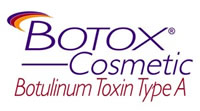BOTOX
 You’ve probably heard a lot about BOTOX® Cosmetic. It’s been in the news, in fashion, health, and beauty magazines, and on TV. Your friends may even be talking about how it works.
You’ve probably heard a lot about BOTOX® Cosmetic. It’s been in the news, in fashion, health, and beauty magazines, and on TV. Your friends may even be talking about how it works.
Could this be what you’ve been looking for—a procedure that can temporarily smooth those moderate to severe frown lines between your brows with no surgery and no recovery time? An improvement can be seen within days, lasting for up to 4 months. Results may vary.
Why would you get treated with BOTOX® Cosmetic?
You think those stubborn frown lines between your brows make you look tired or upset.
It seems like something that you could do to help maintain your appearance.
Almost 3.3 million procedures were performed in 2005 alone—a 16% increase over 2004. Not just models and movie stars, but people from all types of professions have tried it. In fact, the American Society for Aesthetic Plastic Surgery (ASAPS) ranked BOTOX® Cosmetic as the most popular physician-administered aesthetic procedure in the United States for the fourth year in a row (surgical and nonsurgical combined).
What’s more, the ASAPS surveys ranked BOTOX® Cosmetic as one of the low-entry-cost facial aesthetic procedures in the United States.
When it comes to selecting a physician-administered aesthetic treatment, chances are you’ll want proof, not just claims. The proof for BOTOX® Cosmetic is in the numbers.
- In clinical trials, nearly 90% of men and women surveyed rated the improvement in the appearance of frown lines between their brows as moderate to better 1 month after treatment. Results vary.
- Results can last for up to 4 months, and may vary.
- BOTOX® Cosmetic was approved by the Food and Drug Administration (FDA) in 2002 for the temporary treatment of moderate to severe frown lines between the brows in people ages 18 to 65, and almost 3.3 million procedures were performed in 2005 alone.
The American Society for Aesthetic Plastic Surgery ranked BOTOX® Cosmetic as the most popular physician-administered aesthetic procedure in the United States for the fourth year in a row (surgical and nonsurgical combined.


